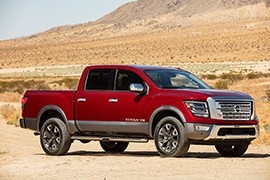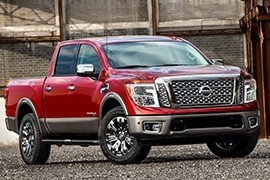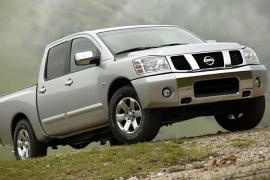
NISSAN Titan Crew Cab
Generations Timeline, Specs and Pictures

For three decades, every pickup manufacturer tries to steal the crown from the Ford F-series and nobody could.
Some of them tried to copy something from the F150 just to do more sales. It is the case with the 2020 Nissan Titan Crew Cab. If there would be no badge on the grille or emboss on the hood, some would think it is a Ford. Apart from that awkward similarity in design, the 2020 Titan looks new and bold, but with optional LED headlights.
Under the tall hood, there is a 5.6-liter V8 gasoline unit that offers 400 hp and 560 Nm (412 lb-ft) of torque. It is mated as standard with a 9-speed automatic transmission. For the off-road, it is prepared with a 4WD system and a locking rear differential.
The bed is not the biggest in its class, but an optional, longer, up to 6 ft (1950 mm) bed will be available. It can be lit-up with some LED-lights inside, to ease the packing when you arrive late at the camping site.
Inside the vehicle, there is room for at least five people. The big interior is equipped with the so-called “zero gravity” seats, which makes the occupants feel like they are floating. For a better interior light, the Titan can be equipped with two sunroofs.

With so many American carmakers’ options, the full-size pickup market was the most difficult to break in.
But Nissan tried to get a slice from it with the Titan XD.
While in other parts of the world, Nissan made a great name for its pickup vehicles, the North-American market was different. Its European or Australian Navara was considered a light-duty pickup, and there were two other sizes to cover. The Japanese carmaker built the Titan, especially to crack that heavy-duty segment. It designed it and built it in the U.S. and took Cummins’ engine to obtain a better vehicle. The transmission remained Japanese.
Big, bold, and square-looking are a must on the heavy-duty pickup segment, and Nissan did that. It installed a big black grille on the front fascia and two headlights that resembled the same shape as those found on the Navara. Depending on the trim level, it featured chromed lower bumper and grille accents. For the Crew Cab version, Nissan installed four doors with the rear ones featuring a wide-open system. The bed was sprayed with special paint, anti-scratching. On the sides, the Titan’s bed featured two storage compartments.
Inside, the front bolstered seats were wide. Between them, the carmaker put a wide center console with a padded armrest and a large storage compartment underneath. There was plenty of room for three in the back, but the carmaker profiled the bench for two and with two headrests.
The technical department worked hard to offer a ladder-chassis able to carry up to 2000 lbs (907 kg) and pull up to 12.000 lbs (5443 kg). While the payload might not impress anyone, the limit was imposed by regulations, not by the Titan’s technical capabilities.

The U.S. pickup market was the most competitive in the world, and Nissan tried to get a slice of it with the big Titan range.
Used as a recreational vehicle and family hauler at the weekend, the Nissan Titan Crew Cab was bigger and more powerful than its predecessor. It was built to offer both comfort and safety on the road. On top of that, it was able to carry heavy loads and pull trailers.
Nissan designers took their job seriously and made the Japanese vehicle look like it came from Dearborn, and its next destination was Texas. A big, chromed grille covered almost the whole area of the front fascia. It was accompanied by a pair of headlights with a curved outer side. For the lower side of the pickup, including the front bumper, Titan featured a special protection area engineered to withstand gravel and dirt like an off-road vehicle. Like any Crew-Cab, Titan featured a pair of doors to access the rear bench. A side step was on the options list to help them climb inside.
The interior was designed to offer the same level of comfort as a premium vehicle. There was a big center console with a storage compartment big enough to hide a six-pack without any trace between the wide front seats. In the back, the bench could accommodate three adults, with enough legroom. The flat floor made things even easier.
Unlike its regular cars, where it offers a wide choice of engines, Nissan prepared the Titan with only one option: a 5.6-liter V8 paired to a 7-speed automatic (dual-clutch) gearbox.

Nissan struck to the core of the American carmakers when it introduced the Titan pickup in 2003 as a 2004 model with an intelligent marketing strategy proving that, sometimes, less is more.
Nissan provided the Titan with only two cab versions, one engine, and one gearbox option. Thus, it reduced the production costs while it still offered more than its American competitors at the same price. Moreover, when the Japanese carmaker ranked 23rd in the JD Initial Quality Study, it sent engineers to the assembly lines. It fixed the problem and jumped on 18th place, ahead of Chevrolet, Dodge, and Ford.
Most pickups were already used as daily drivers, commuter cars, and recreational utility vehicles. Nissan noticed that and offered the Crew Cab as a family vehicle, but with a bed in the back. Since it made only one chassis with one wheelbase, it traded some loading space for a more extended cabin. The Titan’s front fascia was straightforward, evoking a rugged and tough vehicle. Its squared-looking headlights flanked the black grille adorned by two wide chromed trims. The carmaker cut the bumper at the lower side so it could increase the approach angle. The cabin wasn’t connected to the bed on the sides, leading to a quieter interior, while the rear fenders were slightly enlarged. In the back, the corner-mounted taillights flanked the broad tailgate.
Inside, Nissan created a spacious cabin fit for five full-grown adults. The carmaker focused on the driver area and installed individual armrests for each of the front seats. Despite the generous-sized instrument cluster, the carmaker didn’t bother installing too many gauges. It placed only the necessary ones. On top of the center stack, Nissan placed a pop-up navigation screen.
Under the hood, the only option was a 5.6-liter V-8 engine that delivered 317 horses for the 4x4 version. As an experienced off-road car manufacturer, Nissan installed a five-speed automatic transmission and a low-range transfer case for the all-wheel-drive model.























































